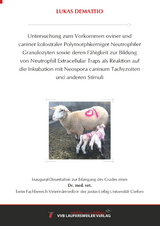Untersuchung zum Vorkommen oviner und caniner kolostraler Polymorphkerniger Neutrophiler Granulozyten sowie deren Fähigkeit zur Bildung von Neutrophil Extracellular Traps als Reaktion auf die Inkubation mit Neospora caninum Tachyzoiten und anderen Stimuli
Seiten
2023
VVB Laufersweiler Verlag
978-3-8359-7165-3 (ISBN)
VVB Laufersweiler Verlag
978-3-8359-7165-3 (ISBN)
Eine ausreichende Kolostrumversorgung ist einer der wichtigsten Faktoren, der die Gesundheit und Entwicklung von Neonaten beeinflusst. Es ist bekannt, dass Leukozyten aus dem Kolostrum, einschließlich polymorphkerniger Neutrophiler Granulozyten, in der Lage sind, über die Aufnahme von Kolostrum von der Mutter zum Neonaten zu migrieren.
Ziel dieser Arbeit war es, die Gehalte an PMN in ovinem und caninem Kolostrum zu ermitteln und zu überprüfen, ob diese Zellen in der Lage sind nach der Passage in das Kolostrums ihre immunologischen Aufgaben, insbesondere die Bildung von NETs, zu erfüllen. Überdies wurde der Verlauf der PMN-Gehalte im Kolostrum und der Transitmilch des Schafes über die ersten 12 Std. nach der Geburt und beim Hund zum Zeitpunkt der Geburt erfasst. Hierbei zeigte sich, dass die Gehalte der PMN beim Schaf in den ersten 12 Std. nach der Geburt annähernd konstant bleiben.
Aus Schafs- und Hundekolostrum stammende PMN wurden zunächst durch Dichtegradientenzentrifugation gewonnen und ausgezählt sowie nach Stimulation mit N. caninum Tachyzoiten und andern Stimuli durch Chromatinfärbung und Antikörper-basierte Immunfluoreszenz von NET-spezifischen Strukturen, einschließlich neutrophiler Elastase (NE) und globaler Histone (H1, H2A/H2B, H3, H4), sowie durch rasterelektronenmikroskopische Analyse (SEM) untersucht. Hierbei wurde zum ersten Mal die Fähigkeit der aus dem Kolostrum von Schafen und Hunden stammenden PMN, NETs gegen den abortiven apikomplexen Parasiten Neospora caninum zu bilden, nachgewiesen. Adequate colostrum supply is one of the most important factors affecting neonatal health and development. It is known that leukocytes from colostrum, including polymorphonuclear neutrophil granulocytes, are able to migrate from mother to neonate via colostrum ingestion.
The aim of this work was to determine the levels of PMN in ovine and canine colostrum and to test whether these cells are able to perform their immunological tasks, in particular the formation of NETs, even after passage of the colostrum. Furthermore, the course of PMN levels in the sheep colostrum and transit milk was recorded over the first 12 h after birth and in the dog at the time of birth. This showed that the levels of PMN in the sheep remained approximately constant during the first 12 h after birth.
Sheep and dog colostrum-derived PMN were first collected and counted by density gradient centrifugation and, after stimulation with N. caninum tachyzoites and other stimuli, examined by chromatin staining and antibody-based immunofluorescence of NET-specific structures, including neutrophil elastase (NE) and global histones (H1, H2A/H2B, H3, H4), and by scanning electron microscopy (SEM) analysis. Here, for the first time, the ability of ovine and canine colostrum-derived PMNs to produce NETs against the abortive apicomplexan parasite Neospora caninum, has been shown.
Ziel dieser Arbeit war es, die Gehalte an PMN in ovinem und caninem Kolostrum zu ermitteln und zu überprüfen, ob diese Zellen in der Lage sind nach der Passage in das Kolostrums ihre immunologischen Aufgaben, insbesondere die Bildung von NETs, zu erfüllen. Überdies wurde der Verlauf der PMN-Gehalte im Kolostrum und der Transitmilch des Schafes über die ersten 12 Std. nach der Geburt und beim Hund zum Zeitpunkt der Geburt erfasst. Hierbei zeigte sich, dass die Gehalte der PMN beim Schaf in den ersten 12 Std. nach der Geburt annähernd konstant bleiben.
Aus Schafs- und Hundekolostrum stammende PMN wurden zunächst durch Dichtegradientenzentrifugation gewonnen und ausgezählt sowie nach Stimulation mit N. caninum Tachyzoiten und andern Stimuli durch Chromatinfärbung und Antikörper-basierte Immunfluoreszenz von NET-spezifischen Strukturen, einschließlich neutrophiler Elastase (NE) und globaler Histone (H1, H2A/H2B, H3, H4), sowie durch rasterelektronenmikroskopische Analyse (SEM) untersucht. Hierbei wurde zum ersten Mal die Fähigkeit der aus dem Kolostrum von Schafen und Hunden stammenden PMN, NETs gegen den abortiven apikomplexen Parasiten Neospora caninum zu bilden, nachgewiesen. Adequate colostrum supply is one of the most important factors affecting neonatal health and development. It is known that leukocytes from colostrum, including polymorphonuclear neutrophil granulocytes, are able to migrate from mother to neonate via colostrum ingestion.
The aim of this work was to determine the levels of PMN in ovine and canine colostrum and to test whether these cells are able to perform their immunological tasks, in particular the formation of NETs, even after passage of the colostrum. Furthermore, the course of PMN levels in the sheep colostrum and transit milk was recorded over the first 12 h after birth and in the dog at the time of birth. This showed that the levels of PMN in the sheep remained approximately constant during the first 12 h after birth.
Sheep and dog colostrum-derived PMN were first collected and counted by density gradient centrifugation and, after stimulation with N. caninum tachyzoites and other stimuli, examined by chromatin staining and antibody-based immunofluorescence of NET-specific structures, including neutrophil elastase (NE) and global histones (H1, H2A/H2B, H3, H4), and by scanning electron microscopy (SEM) analysis. Here, for the first time, the ability of ovine and canine colostrum-derived PMNs to produce NETs against the abortive apicomplexan parasite Neospora caninum, has been shown.
| Erscheinungsdatum | 16.12.2023 |
|---|---|
| Reihe/Serie | Edition Scientifique |
| Verlagsort | Gießen |
| Sprache | englisch; deutsch |
| Maße | 148 x 210 mm |
| Gewicht | 300 g |
| Themenwelt | Veterinärmedizin ► Allgemein |
| Schlagworte | Granulozyten • Neospora caninum • Tachyzoiten |
| ISBN-10 | 3-8359-7165-4 / 3835971654 |
| ISBN-13 | 978-3-8359-7165-3 / 9783835971653 |
| Zustand | Neuware |
| Informationen gemäß Produktsicherheitsverordnung (GPSR) | |
| Haben Sie eine Frage zum Produkt? |

